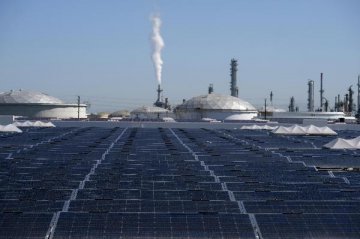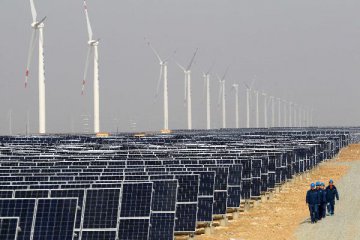
President Donald Trump hasn’t yet managed to devastate any Chinese industries of the future, but the Beijing government has. It may not stay devastated for long, however.
The industry is solar energy, which China seemed poised to dominate until earlier this year. Beijing played a political role to match at the global Climate Change Conference just completed in Poland, brokering a late-hour compromise between rich and poor countries on measuring greenhouse emissions. But back home, solar installations have dropped by one-third compared with 2017, and bellwether stocks like GCL-Poly Energy Holdings (ticker: 3800.Hong Kong) and Sungrow Power Supply (300274.China) have fallen by half.
The cause of this cataclysm is no mystery: an abrupt moratorium on state subsidies for new projects that took effect June 1. China prioritized solar as part of its latest five-year economic plan drafted in 2015, but got more than it bargained for. Green entrepreneurs overshot the 2020 gigawatt target by 2017. That drove a $14 billion deficit in a subsidy fund paid for by power customers, and a thicket of logistical and financial bottlenecks. Solar energy costs twice as much as fossil-fuel equivalents in China, and wind power 50% more, says Dennis Ip, head of power and utilities research for Daiwa Capital Markets in Hong Kong. “The government wants cheap electricity for industry, but it doesn’t have the money to subsidize alternatives,” he says.
Ip expects solar producers to “remain in a depressed state for the near term.” But other analysts are more sanguine. “Actually the recovery is already on its way,” says Frank Yu, a Beijing-based principal consultant for energy specialist Wood Mackenzie. “The market is more adaptable than we thought.”
Beijing looks to be fine-tuning rather than withdrawing its support for solar development, he adds. This autumn it raised the 2030 target for renewable energy from 20% to 35% of total supply putting more onus on consumers to buy more alternative power. A national carbon trading market is on tap for 2020, which should particularly increase the cost of coal-generated electricity. “Environmental and climate change policies will keep favoring renewables,” Yu concludes.
In the nearer term, China’s National Energy Administration convened to revisit alternative energy policy last month. That could lead to some industry rebound through the fiat of increased 2019 solar installation targets, thinks Corrine Lin, chief analyst for the PV Infolink blog in Taiwan. She expects a bounce back to 42.5 gigawatts next year from about 35 in 2018. Meanwhile, solar materials manufacturers are rapidly consolidating to match reduced demand projections.
One important solace for China is that its solar future is in its own hands. Tariffs the U.S. implemented this year on Chinese solar panels are a small part of local producers’ potential market, Woodmac’s Yu asserts. “Domestic demand and demand from other emerging markets are able to absorb the impact of dropping exports to the U.S.,” he says.
The days following the Poland climate summit were rich in energy irony. Chinese industry struggled despite Beijing’s expanding role as a world environmental arbiter. U.S. alternative energy got a dramatic boost even though Washington played the spoiler by talking up coal to the global green audience. An auction for wind power concessions off the coast of Massachusetts shattered all records by raising $405 million after 32 rounds of bidding. That wasn’t the last surprising twist we will see as the top two economies battle for 21st-century predominance. Don’t count the Chinese out yet, though.
Source: Barron’s





















Latest comments